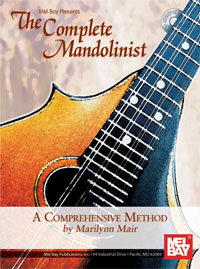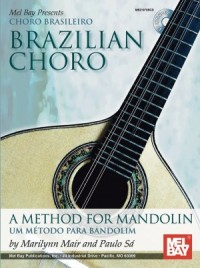This article first appeared in “Mandolin Quarterly” in March 2003.
Here’s a 2nd update to my articles on choro resources. Thanks for all your nice comments about the last column. This issue I’m reviewing 4 books, and will get back to CDs in the next issue. Let’s start out with a great one!
“Vocabulário do Choro (Choro Vocabulary)”
Mário Sève, Luminar Editora, Rio de Janeiro, Brazil, 1999, 221 pp.
Mário Sève plays flute and sax for the modern choro group, “No Em Pingo D’Água”. But more than just a player, he proves, with this book, to be a composer and musicologist of great insight. Sève has analysed the musical language of choro, its stylistic characteristics and performance practice, and has produced a compendium of melodic and rhythmic studies that propose to decode choro’s language for would-be performers by examining the musical elements that create choro’s distinct personality.
Beginning with a section of “Preliminary Studies” in “Rhythmic divisions of phrasing,” “Accents,” “Ornaments and articulations,” “Accompaniments,” and “Structures and harmonic sequences,” Sève outlines the basics of choro writing and performance practice. He uses notated examples to show the fluid flexibility of rhythm used to interpret choro lead sheets, and the parameters of variation a good player must observe. He is clear and specific, and as one plays through his rhythmic figures and variations, it’s as if a whole world of recordings by choro’s great interpreters has been put through a musical Xray machine. This is the heart of the performance practice that personifies choro, how the phrases have actually been changed rhythmically by very subtle changes in beat placement and accent that allows the music to breathe with the performer. These first few pages of the book, Sève notes, are the templates through which to view the 150+ pages of his melodic studies that follow. And as one continues with these studies, one begins to realize that Sève has succeeded, quite simply and miraculously, in putting the characteristics of a style down on paper in black & white.
The bulk of the book, Sève’s “Melodic Studies,” is 130 exercises that each expand a single melodic idea, or “cell” taken from Pixinguinha’s monumental body of choro compositions. Each exercise takes its one-or-two measure idea, sequences it within the key, and then modulates seamlessly through every key signature in a page or two of music. The exercises are written for didactic purposes, but they are also designed to explore the Brazilian phrasing key to choro performance. Applying Sève’s early templates of personal variations of style, ornaments, slur patterns, breathing patterns for winds, a player can vary each exercise to create a world of musical possibilities. Even for those who don’t play choro, these exercises are technically demanding, and much more fun than traditional scales and arpeggios!
The last section of the book is Mário Sève’s composition, “Choro Suite”, written for flute and piano, with a transposed part for sax and chord symbols for guitar. The Suite’s five movements each focus on a form of Brazilian music — choro, waltz, samba, frevo, and baião — and create a nice application for the exercises that come before. Sève’s ability as a composer is clearly evident, and his pieces, while within the idiom their name implys, contain the elements of jazz and contemporary styles found in his work as a performer with “No Em Pingo D’Água” and others.
“Vocabulario do Choro” gives a hand up to those of us who haven’t learned our choro in the streets of Rio. By analysing and codifying the elements of choro style and performance, Sève gives players the chance to develop an ease and familiarity with the choro idiom, one that will make their performances more natural, and more in tune with the parameters of the style. When I wrote my original series of articles on choro for Mandolin Quarterly in 2000, I was worried that the charming tunes of choro were being separated from their performance practice at the hands of bluegrass, jazz, and classical musicians who hadn’t bothered to steep themselves in the recordings of early choro masters. Mario Sève had already considered this possibility, it seems, and his book is a great tool for would-be choristas. “Vocabulario do Choro” goes a long way towards preserving choro performance practice and style for future generations. I got this from the online site for Caravan Music. Highest recommendation.
“Musiques populaires brèsiliennes (Popular Brazilian music),”
Celso Machado, Editions Henry Lemoine, Paris, 1988.
- Paçoca (Choro)
- Quebra Queixo (Choro)
- Piazza Vittorio (Choro Maxixe)
- Algodão (Samba)
- Pè de Moleque (Samba Choro)
For those of us who sometimes play with guitarists unfamiliar with choro style, this book is a treasure. Machado has composed five original tunes with completely written-out guitar parts that encapsulate cool. I recorded “Pe de Moleque” with the World Cafè Quartet, and it’s been a performance hit from the USA to Europe to Japan. The book is somewhat expensive, but highly recommended for those who need it. I got it from Guitar Solo in California (866-788-2255 toll free) who don’t seem to have their books online yet, but do mail order.
” TUDO É SOM (All is Sound)”
Hermeto Pascoal, edited by Jovino Santos Neto, Universal Edition (2001)
- Aquela Coisa – from Lagoa da Canoa, Município de Arapiraca
- Balaio – from Balaio (Richard Boukas/Jovino Santos Neto)
- Bebê – many recordings available
- Bocateando – unrecorded
- Campinas – unrecorded
- Capivara – from Oceano (Sergio Mendes)
- Chorinho pra Ele – from Slaves Mass
- Essa Foi Demais – unrecorded
- Fatima – from Ao Vivo em Montreux
- Floresta – unrecorded
- A Grande Tournê – unrecorded
- Ginga Carioca – from Festa dos Deuses
- Os Guizos – from Hermeto (Brazilian Adventure)
- Haja Coração – unreleased
- Hermeto – from Hermeto (Brazilian Adventure)
- Juvenal no Grumari – unrecorded
- Mata Verde – unrecorded
- Mente Clara – from Só Não toca Quem Não Quer
- Montreux – from Ao Vivo em Montreux
- Música das Nuvens e do Chão – from Cèrebro Magnètico
- Nas Quebradas – unrecorded
- Para Eliane Elias – unrecorded
- Para Miles – unrecorded
- Rebuliço – from Só Não toca Quem Não Quer
- Samba do Belaqua – unrecorded
- Santo Antonio – from Zabumbê-bum-á
- Tacho – from Slaves Mass
- Tupizando – unrecorded
- Vale da Ribeira – from Oceano (Sergio Mendes)
- Viva o Gil Evans – unrecorded
- Viva o Rio de Janeiro – from Caboclo (Jovino Santos Neto Quarteto)
- Voa, Ilza – unrecorded
Hermeto Pascoal is one of the great jazz innovators in Brazilian music, and throughout his career he has performed and written choro alongside his more experimental compositions. Jovino Santos Neto played with Hermeto’s ensemble on keyboard and flute for 15 years, beginning in 1977, and in this book he has compiled a collection of tunes from Hermeto’s vast repertory. They are mostly notated in lead-sheet format, but some have rhythm notations, some have quite complex bass lines written out, and “Música das Nuvens e do Chão” has two sets of harmonic accompaniments & an additional piano part. Although most of the tunes are harmonically light years away from traditional choro style, many show melodic connections to choro tunes, and some are even designated as choro. Jovino includes notes on the pieces in the front of the book, listing their recordings and giving a feel for how their performance should go. I played Rebuliço with piano in a recent choro concert, as an example of choro in the contemporary idiom, and it certainly expanded my musical horizons! You can get the book for $15 from Jovino’s website.
“New Chorinhos from Brazil”
Luiz Simas, Lydjul Music, New York, 1998.
- Chorinho das Comadres
- Chorinho com bossa
- Saltitante
- Chorinho Bachiano
- A Ladeira do Sobe-e-Desce
- Preguiçoso
- Endiabrado
- Teimosa
- Do Coração
- Chorinho do Mar
I mentioned Luiz’s CD in my last article, even though it’s solo piano, because I’ve been performing with him for a couple of years now, and admire his beautiful spirit, both as a performer and as a composer. The pieces here are from his CD of the same name, so you can hear them as well as play them. Although written out as piano scores, there is a strong melody line that can be played on mandolin, and the piano accompaniment figures can be used to create a part for piano, guitar, or a band. Luiz and I recorded “Chorinho com bossa”on my CD “Nadando em Luz,” and have begun performing “Teimosa” (Stubborn Gal) in concert as well. You can buy this book for $18 from Luiz’ website. Luiz also has some tunes from his CDs on the site that you can listen to, including “Chorinho com bossa.”
In addition to the books above, there are lots of choro available on the web, many that can be downloaded for free. In my original articles I mentioned the Samba-Choro website that has many classic tunes and some modern ones available for download, especially if you have the Encore music-writing program. Performer sites often have lead sheets of their original music available too.
If you missed the first articles that I wrote on choro in 2000 for MQ, that issue is, unfortunately, sold out and now out of print. I plan to post the articles on my website in the near future though, so you can catch up on your choro reading this summer while you listen to some cool CDs, order some great books, and dream about Rio.



